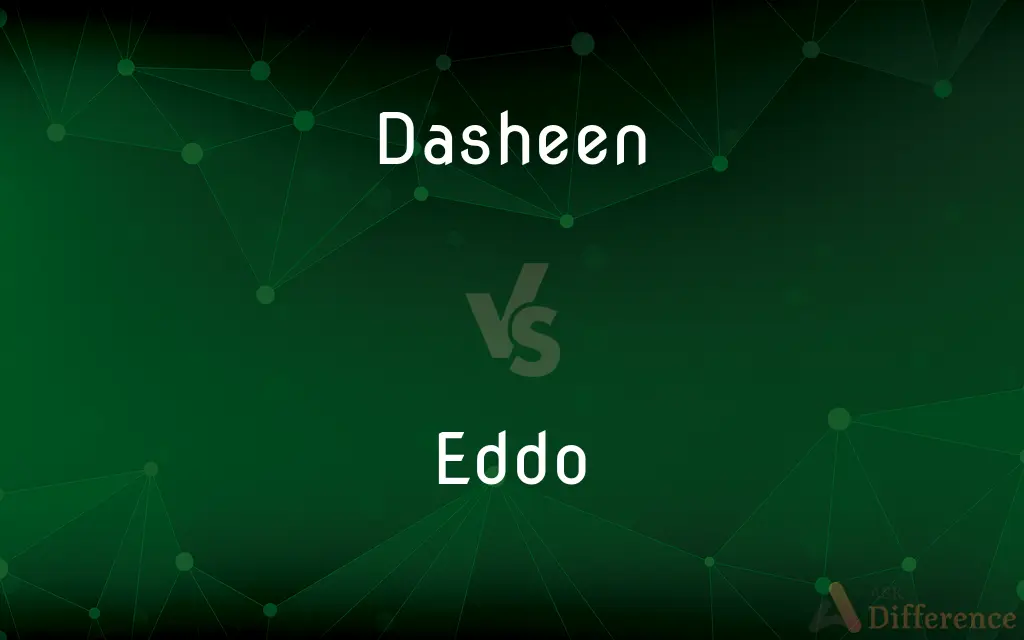Dasheen vs. Eddo — What's the Difference?
By Maham Liaqat & Urooj Arif — Updated on March 19, 2024
Dasheen refers to a tropical root vegetable, also known as taro, while Eddo is a smaller, similar tuber closely related to taro.

Difference Between Dasheen and Eddo
Table of Contents
ADVERTISEMENT
Key Differences
Dasheen, or taro, is known for its large, starchy roots and elephant-ear-like leaves, commonly used in culinary dishes worldwide, whereas Eddo is smaller, with a more pronounced, nutty flavor.
In terms of cultivation, Dasheen requires more space and water, thriving in flooded fields, while Eddo, though also moisture-loving, can be grown in drier conditions.
Nutritionally, both are rich in carbohydrates and fiber, but Dasheen generally has larger corms, providing more edible substance per plant.
Culinary uses of Dasheen often include boiling, baking, and making into stews, while Eddo is prized for its texture and flavor in soups and curries.
The key difference lies in their size, flavor profile, and cultural culinary preferences, with Dasheen being more widely used in various cuisines compared to the somewhat more niche Eddo.
ADVERTISEMENT
Comparison Chart
Size
Generally larger corms
Smaller, more compact corms
Flavor
Mild, nutty, with a starchy texture
More pronounced nutty flavor and texture
Cultivation Requirements
Requires abundant water, often grown in flooded fields
Less water-intensive, can be grown in drier conditions
Culinary Uses
Boiled, baked, used in stews and side dishes
Preferred in soups, curries, and for its distinctive texture
Nutritional Value
High in carbohydrates, fiber, and vitamins
Similar nutritional profile, with slight variations due to size
Compare with Definitions
Dasheen
A tropical root vegetable with large, starchy corms.
Dasheen is a staple in many Pacific Island cuisines.
Eddo
A smaller tuber related to taro, with a nutty flavor.
Eddo is often used in Caribbean and Asian dishes.
Dasheen
Known for its elephant-ear-like leaves used in cooking.
The dasheen leaves were used to wrap fish for steaming.
Eddo
Adapted to grow in less water-intensive conditions.
The eddo crop thrived despite the drier season.
Dasheen
A plant requiring wet conditions for cultivation.
The dasheen field was flooded to ensure optimal growth.
Eddo
Preferred for its texture in soups and curries.
The chef added eddo to the curry for its unique texture.
Dasheen
A source of dietary fiber, vitamins, and minerals.
Incorporating dasheen into the diet can boost nutritional intake.
Eddo
A compact, nutrient-rich root vegetable.
Eddo provides a good source of carbohydrates and fiber in a small package.
Dasheen
Utilized in a variety of dishes worldwide.
Dasheen corms were boiled and mashed as a side dish.
Eddo
Cultivated for its distinctive flavor profile.
The nutty flavor of eddo makes it a favorite in traditional recipes.
Dasheen
The corm of this plant.
Eddo
A variety of taro having small purplish corms.
Dasheen
A tropical aroid (of the genus Caladium, syn. Colocasia) having an edible farinaceous root. It is related to the taro and to the tanier, but is much superior to it in quality and is as easily cooked as the potato. It is a staple food plant of the tropics, being prepared like potatoes, and has been introduced into the Southern United States.
Eddo
The corm of this plant.
Dasheen
A variety of taro having large yellowish corms.
Eddo
A plant (Colocasia esculenta, but often identified as Colocasia antiquorum, among numerous other synonyms), which is usually considered a variety of C. esculenta, with edible starchy tubers.
Dasheen
Old cocoyam; the edible starchy yellow tuber of the taro plant.
Eddo
The tubers of this plant.
Dasheen
A herb of the Pacific islands grown throughout the tropics for its edible root and in temperate areas as an ornamental for its large glossy leaves.
Eddo
Edible starchy tuberous root of taro plants
Dasheen
The edible starchy tuberous root of taro plants.
Dasheen
A tropical starchy tuberous root.
Dasheen
Edible starchy tuberous root of taro plants
Dasheen
Herb of the Pacific islands grown throughout the tropics for its edible root and in temperate areas as an ornamental for its large glossy leaves
Dasheen
Tropical starchy tuberous root
Common Curiosities
Are Dasheen and Eddo interchangeable in recipes?
While they can sometimes be substituted for each other, their differences in size, texture, and flavor might affect the outcome of a dish.
Can the leaves of both Dasheen and Eddo be eaten?
Yes, the leaves of both Dasheen and Eddo can be eaten, but they must be cooked properly to neutralize potential irritants.
How do the flavors of Dasheen and Eddo compare?
Dasheen has a mild, slightly nutty flavor, while Eddo is known for a more pronounced nutty taste and is often considered to have a superior texture.
What are the nutritional benefits of Dasheen and Eddo?
Both are rich in carbohydrates, fiber, and contain various vitamins and minerals, making them a nutritious addition to the diet.
Can Dasheen and Eddo be grown in home gardens?
Yes, both can be grown in home gardens, but Dasheen typically requires more space and a water-rich environment, while Eddo is more adaptable.
What role do Dasheen and Eddo play in traditional cuisines?
They are staples in many traditional cuisines, used in a variety of dishes from stews and curries to side dishes and snacks.
Is there a difference in the way Dasheen and Eddo are harvested?
The harvesting process is similar, but due to size differences, Dasheen might require more effort to harvest due to its larger corms.
Why might someone choose Eddo over Dasheen?
Someone might prefer Eddo for its distinctive flavor, texture, or because it suits specific recipes better, particularly in Caribbean and Asian cuisines.
What is the best way to store Dasheen and Eddo after harvest?
They should be stored in a cool, dry place and used within a reasonable time to maintain freshness and prevent spoilage.
What distinguishes Dasheen from Eddo in terms of cultivation?
Dasheen requires abundant water and is often grown in flooded conditions, while Eddo can be cultivated with less water, making it adaptable to drier conditions.
Are there any common pests or diseases that affect Dasheen and Eddo?
Both can be susceptible to similar pests and diseases, including root rot and leaf blight, which need to be managed for a healthy crop.
How are Dasheen and Eddo prepared to avoid irritation?
Both should be cooked thoroughly to break down calcium oxalate, a compound that can cause irritation when eaten raw.
How long does it take for Dasheen and Eddo plants to mature?
Both plants typically require several months to mature, but the exact time can vary depending on the variety and growing conditions.
Can Dasheen and Eddo be used in modern fusion cuisine?
Yes, chefs increasingly incorporate these versatile tubers into modern fusion dishes, experimenting with their unique flavors and textures.
How do Dasheen and Eddo contribute to food security?
As hearty, nutrient-rich root vegetables, they contribute to food security by providing a reliable food source in many parts of the world.
Share Your Discovery

Previous Comparison
Antipositivism vs. Positivism
Next Comparison
Address vs. PremiseAuthor Spotlight
Written by
Maham LiaqatCo-written by
Urooj ArifUrooj is a skilled content writer at Ask Difference, known for her exceptional ability to simplify complex topics into engaging and informative content. With a passion for research and a flair for clear, concise writing, she consistently delivers articles that resonate with our diverse audience.















































